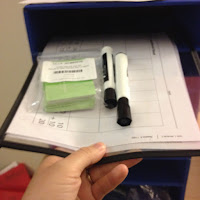Dots
Preparation
The first thing you need is ten copies of the Days in School Activities 1 - 2 Teacher Master. You can find this in your Number Corner Binder, September, behind the Teacher Masters tab.Next, cut them out according to the guide lines, so they look like this:
You should currently be using 1 of these and have 9 dots (5 red on top and 4 blue on bottom). If you do not have dot stickers, please let Amanda or your AP know and we will get you soon. They are so much easier and neater than drawing the dots or taping each day!
Tomorrow, on Day 10, you will put your final blue dot.
On Wednesday, Day 11 you will move this over to another part of your board and start fresh on a new ten frame.
Routine
Make sure to read the routine for each day in your Number Corner binder. Each day, you have a student point at the dots while the class counts. Ask the students how many there will be after today's dot is added. Add the new dot and count again to confirm the total.
Links
Preparation
All you need is a push pen to hang the links on. Today, you should have 5 red links and 4 blue links. Tomorrow you will add your last blue link. The picture below, shows the colors reversed, but same idea.Routine
Each day you follow the same procedure for the links as the dots. Once you have a chain of ten, you will put a second push pin right next to the first and start a new chain - using the same colors as the first.
Classroom Number Line
Preparation
Using 2 different color sentence strips, prepare 18 number line (9 in each color). Measure and mark the strips, as shown below.
Tomorrow you will label the last dot on the first strip as 10 and mark it with a special, color, sticker, or shape. On Wednesday, you will add the second strip in the other color and begin working your way to 20. Here is what it will look like after day 20, you are just repeating the same process!
Routine
Each day point and read the numbers on your number line, and then work with input from the class to record the next number.










































.png)


